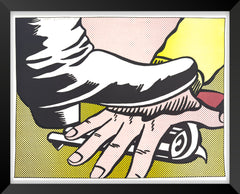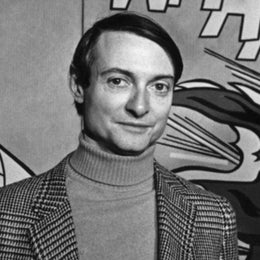
| Current Roy Lichtenstein Inventory | Recent Roy Lichtenstein Sales |

Roy Lichtenstein - Artworks for Sale

Roy Lichtenstein: Redefining American Art with Pop Culture
Today, American artist Roy Lichtenstein is considered one of the most influential and innovative figures from the second half of the 20th century. Helping originate the Pop Art movement, his bold and vibrant palette parodied American popular culture through a comic strip aesthetic.
Lichtenstein was born on October 27, 1923, in New York City. At a young age, he showed both artistic and musical ability and passion. His interest in the arts continued to his adolescent years. He continued pursuing drawing, painting, and even sculpture. And in the summer of 1940, he studied painting and drawing at the Art Student League of New York.
During the early years of his career, Lichtenstein embraced a European Modernist style to capture uniquely American subjects. Since early on, Lichtenstein’s practice gravitated towards the notion of taking the “worst” visual style he could find and then altering or improving it. One of the first themes explored in his paintings and prints was the satirical interpretation of medieval knights, castles, and maidens. Another subject he investigated was the reinvention of nineteenth-century American genre paintings found in history books into Cubist depictions of cowboys and Indians. By the late 1940s and early 1950s, the iconography in his art started coming from printed images.
In 1960, a period when commercial art or mass-produced art was seen in contempt by the art world, Lichtenstein broke away from his previous aesthetics and began work on his now-iconic comic strip works. His new art focused on the artifice of conventions and taste that permeated art and society at the time. He took visual imagery dismissed as trivial and reinterpreted as a classic and idealized American subject matter. He portrayed them in an ironic style and featured close examinations of illusionism and the representation of reality in art. Additionally, he explored contrasting themes of reality compared to artificiality, the differences between high art and mass culture, abstract and realistic interpretations, and the manual versus the mechanical. The juxtaposition of contrasting ideas revealed their interdependence.
After gaining critical acclaim in the 1960s, Lichtenstein’s art stopped referencing comic books and instead alluded the art of early 20th-century masters Pablo Picasso, Henri Matisse, Fernand Léger, and Salvador Dalí. Though his themes and medium continued evolving since the 1970s, Lichtenstein continued to paint using his trademark painted screen-print style. He was a very prolific artist, creating over 5,000 paintings, prints, drawings, sculptures, murals, and other objects. His art provoked debate over ideas of originality, consumerism, and the distinction between art and entertainment.
Today, his artworks continue to be the subject of many retrospectives and exhibitions around the world. His work is part of the collections of various museums such as the Museum of Modern Art (MoMA), the Whitney Museum of American Art, the Art Institute of Chicago, Los Angeles County Museum of Art (LACMA), Solomon R. Guggenheim Museum, The Metropolitan Museum of Art, Tate Modern, the National Gallery of Australia, and Kunstmuseum Basel.
Subscribe to our newsletter to get an instant alert when we add the next piece by Roy Lichtenstein
| Current Roy Lichtenstein Inventory | Recent Roy Lichtenstein Sales |